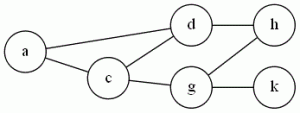Tag Archives: Difficulty 3
Protected: Feedback Vertex Set
Protected: Minimum Sum of Squares
Protected: Largest Common Subgraph
Clique
G&J don’t even bother to prove Clique is NP-Complete, just stating that it (and Independent Set) is a “different version” of Vertex Cover. But the problem comes up often enough that it’s worth seeing in its own right.
The problem: Clique (I’ve also seen “Max Clique” or “Clique Decision Problem” (CDP))
The definition: Given a graph G=(V,E), and a positive integer J (G&J say J needs to be ≤ |V|, but I think you can allow large values and make your algorithm just say “no”). Does J contain a subset V’ of V, or size at least J, where every two vertices in V’ are joined by an edge in E?
Example: Using the graph we had for VC:
{a,c,d} form a clique of size 3. There are no cliques of size 4, but if we add the edge (d,g) and the edge (c,h), then the vertices {c,d,g,h} would be one.
The reduction: From Vertex Cover. Given a graph G and an integer K that is an instance of Vertex Cover, take the complement of G (the complement of a graph has the same vertices, but the set of edges is “inverted”: (u,v) is an edge in the complement if and only if it was not an edge in G), and use it as your instance of CDP. Set J= |V|-K
Difficulty: 3. It’s not a 2 because it takes a little thought to see why the complement works.
Note: As stated perviously, I teach this course using the Cormen book, so in class I show Clique is NP-Hard by reducing from 3SAT. It’s a good example of a hard reduction, probably about as hard as the VC reduction G&J do.
Exact Cover by 3-Sets
This is not one of the “core six”, but it is used a lot in reductions, so it’s worth including since it builds right off of 3DM
Also, I think I will include examples for lots of these problems. Lots of times I have trouble parsing the problem description, so creating a concrete example is helpful.
The problem: Exact Cover by 3-Sets (X3C)
The definition: Given a set X, with |X| = 3q (so, the size of X is a multiple of 3), and a collection C of 3-element subsets of X. Can we find a subset C’ of C where every element of X occurs in exactly one member of C’? (So, C’ is an “exact cover” of X).
Example: Suppose X was {1,2,3,4,5,6}
If C was {{1,2,3},{2,3,4},{1,2,5},{2,5,6}, {1,5,6}} then we could choose C’ to be {{2,3,4},{1,5,6}} as an exact cover because each element in X appears exactly once.
If instead, C was {{1,2,3},{2,4,5},{2,5,6}}, then any C’ we choose will not be an exact cover (we need all 3 subsets to cover all elements in X at least once, but then the element 2 appears three times).
Note that if we do have an exact cover, C’ will contain exactly q elements.
The proof:G&J prove this “by restriction” which basically means that they show how X3C is a more general version of 3DM . If you view an instance of 3DM as a special case of X3C by letting XX3C = W∪X3DM∪Y and C = all q3 triples taking one element from W, one element from X3DM, and one element from Y), then the C’ you get as a solution to X3C is also a matching for 3DM.
(Note that lots of these reductions will be between problems that use the same symbols in both problems. I’ll do my best to disambiguate by using subscripts to mark where the common letter comes from. So, in this case X3DM is the set X that we get from the 3DM problem (one of the 3 input sets), and XX3C is the set we build for the X3C problem (the set we need to cover). Hopefully that doesn’t make things more confusing)
(Also note that like many (most?) Computer Science people, I’m a big fan of nested parentheses. I’m sure all of you can follow along with that. (Right?))
Personally, I don’t like proofs by restriction as a way to teach this stuff to students. It’s very easy to mess up the “this is a special case” argument- you get incorrect arguments like “this is just a special case of SAT where we return true wherever there’s a cover and false when we don’t!”. Also it feels like you’re going backwards from a real reduction, and since getting the direction wrong is probably the #1 most common issue students have in doing reductions, anything that makes their job harder isn’t a great idea.
If I taught this in a class, I’d make them do a proper reduction out of it- start with an instance of 3DM (W, X3DM, and Y), and build an instance of X3C (creating XX3C and C), and going from there.
Difficulty: 3. It’s only not a 2 because I, at least, have trouble understanding what the X3C and 3DM problems are asking. It’s not as straightforward to explain as many other problems
